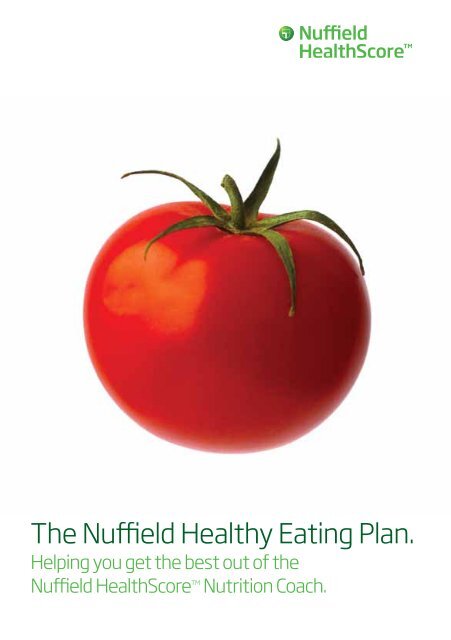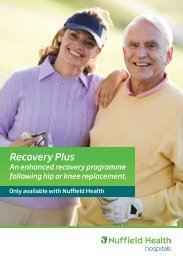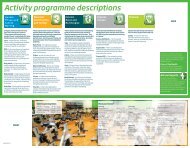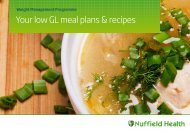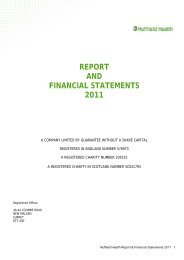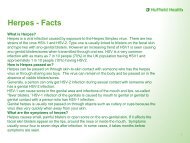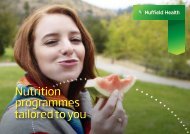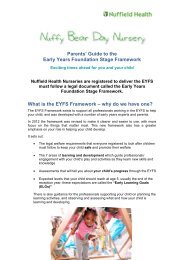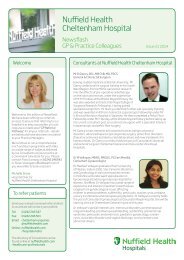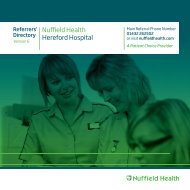The Nuffield Healthy Eating Plan.
The Nuffield Healthy Eating Plan.
The Nuffield Healthy Eating Plan.
- No tags were found...
Create successful ePaper yourself
Turn your PDF publications into a flip-book with our unique Google optimized e-Paper software.
2) How ourHealthScoreNutrition Coach helpsAs part of <strong>Nuffield</strong> HealthScore, theNutrition Coach is designed to help youachieve long-term wellbeing and reduceyour risk of illness and disease.First it assesses your current nutritionalbehaviour, based on your eatingand drinking habits. <strong>The</strong>n it usesthat information to guide you in apersonalised way towards a healthierway of eating.It’s all geared towards changing yourhabits, from bad to good. After all, whatyou eat, why you eat and how much youeat is largely a question of habit.<strong>The</strong> Nutrition Coach supports you in twokey ways:• It tracks your eatingbehaviour –by asking a range of simplequestions, the Nutrition Coachlearns about your specifichabits and needs.• It gives you ongoingprompts and advice –to keep you motivated andsteer you towards the positivebehavioural changes you needto make.<strong>The</strong> Nutrition Coach is farmore sophisticated than a simplecalorie counter.It is an intelligent and personalisedsystem. It learns all about you and basesits advice on what it learns, setting youpersonalised goals around the areas itthinks you need to work on.It gets to know the foods you choose, andall your other eating and drinking habits.<strong>The</strong> Nutrition Coach is inspired by aMediterranean lifestyle, well known forits combination of nourishing cooking andhealthy living. Even if you only look at itpurely in terms of weight loss, it performsbetter than a low-fat diet and about thesame as a low-carbohydrate diet.<strong>The</strong> Nutrition Coach has been developedby nutritional experts together withhealth and wellbeing experts. <strong>The</strong>development process has been overseenby an independent medical advisoryboard, with the content assessed by abehavioural psychologist. This scientificrigour is what makes the Nutrition Coachso different from other nutrition tools.As you use the Nutrition Coach, you’llreceive a Nutrition Score, which affectsyour overall HealthScore. Your NutritionScore changes in real time, dependingon the answers you give and the goalsyou achieve.You can access the Nutrition Coachthrough the HealthScore website or app.Go to nuffieldhealthscore.com anddownload the <strong>Nuffield</strong> Healthscoresmartphone app to get started.6 7
3) Introducing our<strong>Nuffield</strong> <strong>Healthy</strong><strong>Eating</strong> <strong>Plan</strong>Based on a Mediterranean style ofeating, the <strong>Nuffield</strong> <strong>Healthy</strong> <strong>Eating</strong><strong>Plan</strong> combines 3 core principles of basichealthy eating and living:1. Plenty of plant foods (fruitand veg), whole grains,nuts and seeds.2. Seasonal fresh foods ratherthan processed foods .3. A healthy, active lifestyle,underpinned by exerciseand taking time out to enjoyyour food.<strong>The</strong>se are backed up by a range ofsensible nutritional choices. For now, allyou have to do is remember our HIGH,MODERATE, & LOW pointers:1. HIGH intake of fruit,vegetables, nuts, seeds,whole grains and cereals.2. MODERATE intake of olive oil,fish and poultry.HIGHMODERATE<strong>The</strong> key thing to remember is: choosefresh, choose seasonal. And enjoyyour food!Like most good healthy diets, the<strong>Nuffield</strong> <strong>Healthy</strong> <strong>Eating</strong> <strong>Plan</strong> promotesfresh fruits, vegetables, oily fish, leanmeats and whole grains. At the sametime, it encourages you to limit theamount of unhealthy saturated fatsyou consume from red meat and dairyproducts, as well as the amount ofsugar and salt from processed foodsand sweet treats.We put the emphasis on sharing mealswith family or friends. If you can, makeevery meal an occasion, even if it’s just byputting on your favourite music.And don’t worry, the occasional glass ofred wine with a meal is not a problem.We’ve chosen this approach for a numberof reasons.First, it’s easy to stick to, because theemphasis is on finding healthy foodsthat you love eating. It’s about makingpositive choices to enhance yourenjoyment of food and life.• Reduced overall mortality.• Reduced cardiovascularmortality.• Reduced incidence of cancer.• Reduced cancer mortality.• Reduced incidence ofParkinson’s disease.• Reduced incidence ofAlzheimer’s disease.When you’re eating healthily, youshould also notice better energy levels,improved mood, glowing skin, as well asimproved sleep and mental performance.3. LOW intake of dairy products,red meat, processed meats,sweet foods.LOWAlso, it works. Current research stronglyassociates this kind of healthy eatingplan with the following health benefits:8 9
4) How we eatis as importantas what we eatA recent randomized Spanish trial ofdiet patterns published by the NewEngland Journal of Medicine in April2013 followed almost 7,500 individualsover 5 years. 3 This was the first majorclinical trial to measure food intakeeffects on cardiovascular, heart risksand mortality in general populations.<strong>The</strong> scale of the benefits fromMediterranean-style eatingastonished researchers: the studyconcluded that a diet low in saturatedfat, supplemented every day withextra virgin olive oil and mixed nutscould reduce the risk of a majorcardiovascular event by 30%.GLOWINGSKININCREASEDENERGYBETTERMENTALPERFORMANCEIMPROVEDMOODIMPROVEDSLEEPStudies show that eating with friends orfamily influences our decisions over whatwe eat. We become more mindful of ourfood choices, going for healthier optionsreinforced by our companions’ choices.If you are eating alone, planning aheadcan reduce the temptation to eat lesshealthy foods. Draw up a list of mealsfor the week, so you can make sure youhave the fresh ingredients in when youneed them.<strong>Eating</strong> with friends and family turns mealtimes into an event rather than a quickfood fix. When you enjoy a leisurely mealin a relaxed environment, you’re givingyour body the opportunity to digestproperly. So you get the maximum benefitfrom the healthy food you’re eating.Also, make sure you don’t bolt downyour food. Taking time to chew your foodwell supports good digestive function,allowing your body to break down andabsorb nutrients more effectively.Rushing your meals, eating on the goor when stressed, can lead to sluggishdigestion and poor absorption ofnutrients. It could result in symptoms suchas gas, bloating and feelings of fullness.MON 12 FEBRUARYChivesKaleRocketLemonsOlive oilAsparagusAvocadoSalmonWild rice3) Sources: Estruch, R., et al (April 4, 2013). Primary Prevention of Cardiovascular Disease with a Mediterranean Diet.New England Journal of Medicine. doi:10.1056/NEJMoa1200303. Retrieved February 25, 2013.2012 British Heart Foundation, Coronary Heart Disease Statistics 2012 .10 11
5) Shoppingfor health<strong>Healthy</strong> eating starts in the supermarket.<strong>The</strong> choices you make when filling yourbasket are crucial. In general, werecommend that you always choosefresh, local, seasonal goods overprocessed food, such as ready mealsor even bacon.Here’s why fresh, local, seasonalis always best:• It tastes better – when thefood you’re buying is in linewith the seasons, it’s fresher,tastier and more nutritious.• It can be cheaper - you avoidpaying a premium for food thathas travelled a long way and isin short supply.• It’s better for the localeconomy – you’re supportinglocal farmers.• It’s not junk - processed foodsoften contain more salt, sugarand saturated fats which weall know are bad!• It’s better for theenvironment – the furtheryour food has travelled, thegreater its carbon footprint .But why is processed food so bad?Processed food is any food you don’t cookyourself, or that has been partly preparedwhen you buy it. <strong>The</strong> processing thatis required to prepare the food actuallyremoves many, if not all, of the vitamins,minerals and fibre in the food.From a nutritional point of view, the foodbecomes worthless, or even harmful.Instead of important nutrients, thefood may be filled with additional sugar,unhealthy saturated fats and additives.Most pre-packaged foods fall into thiscategory: biscuits, cakes, pastries,crackers, breakfast cereal, ham,sausages, burgers, frozen pizza and even“healthy” frozen dinners.<strong>The</strong> reason we’re all tempted to fill ourbaskets with processed foods is becausethey’re all the things we like to eat. We canstill enjoy them - we just have to createour own, non-processed alternatives.Try making your own pizza from wholegrain flour. Or why not cook your ownturkey breast, then slice and freeze it?You’ve got a convenient, ready-madesupply of healthy protein for sandwichesor salads.It all comes down to making some simple,healthy choices the next time you’re inthe supermarket. For example, try steelcut oats instead of instant porridge oats.Steel cut oats are better for you becausethey preserve the whole grain.And remember, where you can, choosefresh, local, seasonal. It’s important tochoose local because some nutrients,such as vitamin C, deteriorate over timein storage and shipping. Fresh locallygrown foods that are in season containmore of these nutrients.Also, you’ll never be bored. Variety is thespice of life, after all. Every season bringsdelicious new choices.12 13
<strong>The</strong> Nutrition Coach staples for your kitchenHere is a good pantry list to get you started for all your Nutrition Coach cooking needs:CupboardStaplesSeasoningsCannedand/or driedBread bin• Baking powder, bakingsoda, and corn flour• Dry yeast• Extracts: pure vanilla,anise, and almond• Flours: whole wheat,wheat bran, oat, andall-purpose• Sugars: granulated andlight or dark brown sugarUnsweetened cocoa• Oils: olive oil, extra-virginolive oil, canola oil, andnon-stick cooking spraySea salt, black pepper,ground cumin, paprika,garlic powder, chili powder,curry powder, ginger,cinnamon, dill, parsley,tarragon, basil, oregano,thyme, rosemary, includeyour own choice of herbs(frozen or dried)• Beans: black beans, pintobeans, or white beansLentils• Canned soups:minestrone, vegetable,or tomato• Rice: wild rice andbrown rice• Pearl barley, quinoa,or bulgur wheat• Whole meal pasta• Oatmeal• Whole meal breadBasic fridgeFrozenitemsIdea forcooking andside dishesKitchencounter topproduce• Eggs• Fresh vegetables:lettuce for salads,carrots, tomatoes,cucumber and celery• Lean deli meats• Cheese• Low-fat Greek yogurt• Milk or cottage cheese• Nuts and seeds (store inrefrigerator to keep fresh)• Natural nut and seedbutters like almondbutter or pumpkin seedbutter• Condiments: mustard,Worcestershire sauce,salsas, and mayonnaise• Frozen vegetables suchas spinach, cauliflower orbroccoli• Low-sugar frozen fruitsuch as blueberries andstrawberries• Boneless, skinlesschicken breasts• Fish fillets or salmon• Frozen prawns (cookedor raw)• Extra-lean ground beef• Precooked meals: soups,stews, and chillis• Fruits: Apples, Satsuma,apricots, bananas, andpears.• Lemons and limes• Onions and garlic• Avocadoes6) What’s inyour basket?In this chapter we look at differentingredients and food groups, givingyou the information you need to makehealthier eating choices.14 15
Essential fatsand oilsNot all fat is bad. Good fats are anessential part of a healthy diet and weshould be consuming them every day.<strong>The</strong> technical term for good fats isunsaturated fats or oils. <strong>The</strong>y are alsocalled essential fats, because we need toeat them.<strong>The</strong>y include mono- and polyunsaturatedfats. <strong>The</strong>y are liquid at room temperatureand are mostly found in plant foods (forexample, nuts, seeds and vegetable oils)and oily fish (such as mackerel, salmonor tuna). Omega-3 fats are classified aspolyunsaturated fat.<strong>The</strong>se good fats actually help your bodyabsorb nutrients from other foods. <strong>The</strong>yalso help lower cholesterol levels, bloodpressure and reduce the risk of heartdisease. A recent French study of peopleaged 65 and over concluded that olive oilreduced the risk of stroke by 41%.Bad fats are called saturated fats.Saturated fat is usually solid at roomtemperature. It’s most commonly foundin animal products.A diet high in saturated fats can lead toa number of serious health problems,including obesity, heart diseases, andcancers of the breast and colon.Here’s a guide to which foods containgood fats, and which bad:Unsaturated Good FatsEat more of theseOily Fish:Sardines, Mackerel,Herring, SalmonOlive OilVegetable OilNuts (Walnuts, Almonds)Seeds (Flax, Sunflower)AvocadoSaturated Bad FatsEat less of theseRed Meat:Beef, Lamb, PorkProcessed Meats:Bacon, Salami, SausageDairy Products:Milk, Cream, Butter,Cheese, Yoghurt16 17
Fats and oils are often used in cooking, but it’s a good idea to limit the amount of oil youuse and if possible avoid frying food whenever possible. Instead of deep-fat frying, orroasting in oil, try:• Stir-frying• Grilling• Steaming• Poaching• BakingBags offruit & vegOlive oil is tasty and healthy – it’s particularly high in monounsaturated fats, which canhelp lower overall cholesterol, including so-called ‘bad cholesterol’ (technically known aslow-density lipoprotein, or LDL cholesterol).Here’s a simple guide to the different types of olive oil available:Extra virginolive oilHighest grade of olive oil, extracted from the olivemechanically, without using chemicals or excessive heat,or any methods which could change the quality of the oil.Use this oil for salads or drizzling over vegetables.Virgin olive oilExtracted solely from the olive, using physical ormechanical methods that do not affect the quality.Refined olive oil,sometimes called“pure olive oil”Extracted from lower quality or defective olives usingtreatments including chemical and physical filters.No solvents are used.18 19
Carbohydrates generally get a badname. But they do vary in their nutrientcontent, the speed at which they areabsorbed into the blood stream and howquickly they supply the body with energy.Almost all carbohydrates are brokendown in the digestive tract into glucose(sugar). Glucose is fuel, used for energyby our brain and our body. <strong>The</strong> amountof glucose in the blood at any one time isreferred to as ‘blood sugar level’.Simple carbohydrates, on the other hand,are low in nutrients and fibre, which iswhy you should try to eat less of them.<strong>The</strong>y are what we call ‘energy dense’.What this means is that, because oftheir lack of fibre, they are quicklydigested and absorbed into the bloodstream. This affects our blood sugarlevels and causes an energy rush.This surge of energy is always followedby a crash or energy low, known as bloodsugar imbalance.Carbohydrates form two basic groups:Blood sugar levelInsulin levelsGood andbad carbs• Complex – such as whole grains,beans, pulses, brown rice, oatmeal,vegetables and fruits.• Simple – such as sugar, white flour,white pasta, white rice, biscuits,sweets, alcohol, and processed cereals.Good health comes from includingpredominantly complex carbohydratesin the diet, which are high in fibre andnutrients. Fortunately, these are theones that have a better flavour.Complex carbohydrates are digestedslowly and so release their natural sugarsmore steadily. For this reason, theyprovide a stable slow release of energy,and give a more lasting sense of satietyand feeling full.fat storage zoneIdeal rangeHunger zoneBalanced blood sugar curve 4&5Blood sugar levelInsulin levelsLunch3pm slumpImbalanced blood sugar curve 4&54) <strong>The</strong> Whole Grains Council5) <strong>Nuffield</strong> Health source22 23
ProteinprioritiesIf you’re trying to move towards ahealthier diet, it’s common senseto include more whole grain thanrefined grain.Whole grains offer many healthbenefits, including:• Blood glucose control(reducing risk for diabetes)• Reduced colon cancer risk• Controlling high blood pressureExamples of whole grains:• Oatmeal• Whole wheat bread• Brown rice• Whole rye• Spelt• Quinoa• Whole wheat pasta• Whole grain bread<strong>The</strong>se days, all these foods are widelyavailable at supermarkets, health foodstores and online.A healthy guideline is that thesenutritious whole grains should take up aquarter of your plate. Here are some tipsto help you get the balance right:• Replace white bread, whiterice, and white pasta withwhole grain, whole meal orbrown varieties.• Add barley or bulgur to soups,stews, or casseroles.• Instead of using refined whiteflour for baking, switch towhole wheat or whole mealflours.• Choose whole grain crackersand use whole grain breadcrumbs in recipes.• Eat whole grain breakfastcereals such as steel cutporridge oats.• Use oatmeal or whole wheatflour when making cookiesor biscuits.• Whole wheatready-to-eat cereals24 25
Proteins are used in our body forstructure, repair, growth and hormoneproduction. Protein also slows thedigestion process meaning glucose isabsorbed into the blood at a slower rateProtein falls into two categories:1. Animal sources of protein are thehighest quality, providing the bodywith all the essential building blocks(amino acids) for life.2. Vegetable sources of protein containdiffering amounts of these essentialamino acids. In order to obtain all theessential amino acids required forhealth, different types of vegetableproteins must be combined at mealtimes. Vegetable sources of protein arealso naturally low in saturated fat, oreven contain none at all, and so can beconsumed regularly<strong>The</strong>re’s no one-size-fits-all solution tohow much protein we should eat daily.For example, it can vary by age. Also, menand women require different amounts.<strong>Healthy</strong> sources of protein include:• Nuts and seeds• Eggs• Whole grains• Chickpeas• Beans• Quinoa• Soya• Chicken• Turkey• Mackerel• Salmon• Sardines• Pilchards• Herring• Kipper• Whitebait• Fresh tuna• Trout• Anchovies• EelSo a good tip is to include a healthyprotein in each meal time, as long as it’snot always from an animal source.If you do like red meat (such as beef, pork,or lamb) always choose lean cuts. Go formoderately sized portions and only eat itoccasionally. A good rule of thumb is thatyour protein portion should be about thesize of a pack of cards.But remember, research has linked theconsumption of red meat to higherrisk of developing colon cancer, heartdisease, and diabetes, as well as a higherrisk of mortality from heart disease, andcancer. However, a small amount of redmeat can be good for you as it’s a goodsource of iron.As well as being high in protein, oily fishis an excellent source of iron, and, mostimportant of all, is rich in a healthy fatknown as omega-3 fatty acid.Omega-3 fatty acids have a number ofhealth benefits and can be helpful inthe prevention and treatment of manyconditions including:• Childhood asthma• Prostate cancer• Heart disease• High blood pressure• Inflammatory conditions(i.e. arthritis)• Mental health disorders• Diabetes• Digestive disorders• Autoimmune disease• Cancer<strong>The</strong>se good fats have to be obtainedfrom the foods we eat, as the bodycannot make them. That’s why it’s soimportant to include oily fish in our<strong>Nuffield</strong> <strong>Healthy</strong> <strong>Eating</strong> <strong>Plan</strong>. White fishalso contain these fatty acids, but atmuch lower levels than oily fish.Try to choose smaller fish, such as herringand sardines, which have lower levelsof harmful mercury. This is particularlyimportant for pregnant women, womenplanning pregnancy and children up tosix years.Oily fish can be eaten canned, fresh orfrozen, although canned tuna has muchless omega-3 fats. Its levels are similarto white fish. <strong>The</strong> current thinking isthat we should eat two portions of fisha week to gain their health benefits. Aportion is 140g.LESSMORE26 27
Nuts and seeds are nutritious, tasty,and portable - perfect for snacking.<strong>The</strong>y’re also great for adding to saladsor breakfasts for a bit of extra, healthy,crunch.Naturally, a little of what you fancy isgood for you. However, grazing on toomany nuts and seeds can be calorific.Nuts are good for us because theycontain fibre, which supports digestion.<strong>The</strong>y are also rich in protein, whichprovides energy and helps build leanmuscle. What’s more, nuts and seeds arenaturally cholesterol-free, with very littlesaturated fat.Remember to choose unsalted andunroasted varieties. Otherwise they canbe high in salt, which could undo all thegood work you’re doing by choosing nutsin the first place.A serving of nuts (approximately a smallhandful) has been shown to preventweight gain and may even promoteweight loss as part of a calorie-controlleddiet. This could be because when we eatnuts, the protein, fibre and good fats theycontain help us feel full. So we don’t feelthe need to snack on less healthy foods.Research has shown that people whoeat nuts regularly have a lower incidenceof type 2 diabetes compared to thosewho don’t. 6Here are some good nuts to include inyour handful of health:• Walnuts• Almonds• Pecans• Brazil nuts• HazelnutsSeeds are good for our health too, forthe same reasons as nuts. Here are somehealthy seeds to crunch on:• Pumpkin seeds• Flax seeds• Sesame seeds• Sunflower seedsA healthyhandful of nuts6) Trichopoulou, A., et al., (2009), Anatomy of health effects of Mediterranean diet: Greek EPIC prospective cohortstudy. B,MJ 2009; 338 doi: (Published 23 June 2009). Cite this as: BMJ 2009;338:b2337 Estruch, R., et al (April 4, 2013).Primary Prevention of Cardiovascular Disease with a Mediterranean Diet. New England Journal of Medicine. doi:10.1056/NEJMoa 1200303. Retrieved February 25, 2013.28 29
<strong>Healthy</strong>hydrationWater is essential to health. After all, it’sa major component of our bodies. <strong>The</strong>average adult human body is 50-65%water. <strong>The</strong> best way to think of it is asone of our six basic nutrients alongsidecarbohydrates, fats, vitamins, proteinsand minerals.Good hydration can help prevent andtreat many ailments such as:It doesn’t have to be all water. You canalso drink some tea, coffee, fruit juice orother drinks.Of course, there are other ways of takingfluids on board. In the UK, we drink about165 million cups of tea every day andabout 70 million cups of coffee. 7• Urinary infections andincontinence• Heart disease• Diabetes• Low blood pressure• Cognitive impairment• Constipation• Pressure ulcers50-65%WATER• Bad skin• Low energySo it’s really important that we keepourselves hydrated by drinkinglots of water through the day. <strong>The</strong>recommended intake is 1-2 litresthroughout the day, sipping regularlyrather than drinking lots in one go.7) <strong>The</strong> UK Tea Council30 31
Relaxing withthe odd glassIf you are one of the nation’s caffeinelovers, it’s worth being aware of thehealth implications. If you ever sufferfrom jitteriness, interrupted sleep orincreased anxiety, it may be that you’redrinking too much caffeine.If you’re pregnant, or have troublecontrolling your blood sugar or bloodpressure, it may be an idea to cut downthe amount of coffee you drink, or cut itout all together.Caffeine is found in:• Coffee• Tea• Energy drinks• Coke• Dark chocolateDrinking some varieties of coffee can alsopile on the pounds over time. That latteyou pick up on your way to work couldcontain up to 500 calories, especially ifyou go for a big cup. As an experiment,try pouring a grande size coffee into aregular size mug. You may be surprisedhow much coffee you’re drinking.Many people don’t realise these drinksadd to their total energy intake. Whichmeans they may not compensate forthose extra calories by eating a littleless during the day. For a calorie-freeoption, take your coffee black with noadded sugar.Researchers used to believe that evena moderate amount of caffeinateddrinks had a diuretic effect. It wasthought that they increased urinationafter consumption, which would lead todehydration. However, the most recentresearch shows this is not the case. It’sonly at high quantities (5-7 cups a day)that caffeine can have a diuretic effect.If you are in the habit of drinking a lotof coffee or tea, try replacing one ortwo cups with caffeine-free varieties,or herbal teas such as peppermint orrooibos tea. <strong>The</strong> key is to make smallchanges over time.<strong>The</strong>re are no recommended upper levelsfor how much caffeine you can drink.But for a healthier lifestyle, water issimply the best way to stay hydrated.It is inexpensive, readily available andcalorie-free.32 33
<strong>The</strong> NutritionCoach Plateof HealthHydration is important, too little or toomuch are equally unhealthy. Aim for 8glasses of fluid a day depending on youractivity levels and climate. Water is best,limit milk / dairy; avoid tea, coffee, andsugary drinks.Eat a variety of wholegrains such as wholewheatbread, wholegrain pasta, brownrice, quinoa, bulgerwheat, barley, limitwhite rice, white pastaand white bread.<strong>Healthy</strong> oils such as olive oil forsalads, cooking and for dippingAvoid fried fats and oils heatedto high temperatures.Eat vegetables, the morebrightly coloured and themore variety you can eatthebetter. Reduce intake ofstarchy vegetables such aspotatoes and chips.8) <strong>Healthy</strong>eating tipsBeat those hunger pangsA good way to avoid hunger is to eatregular healthy meals and snacksthroughout the day.Breakfast is important because it boostsyour metabolism after resting overnight.A good, healthy breakfast also ensuresa steady blood sugar level throughoutthe morning. Oats with fruit, nuts andseeds plus milk or rice milk and yoghurtare ideal choices.To avoid mid-morning or mid-afternoonenergy crashes, eat a healthy snacksuch as blueberries and a palmful ofpumpkin seeds, a couple of hours afterbreakfast and lunch. This helps yourblood sugar levels to remain stablethroughout the day.Lunch and dinner should contain a goodprotein from animal or vegetable sources.Try drinking a glass of water and waiting30 minutes before eating. It may helpyou cut down the amount of food you’reeating.<strong>The</strong> secret of healthy snacking<strong>Healthy</strong> snacking can easily be achievedwith a little planning and preparation.<strong>The</strong> key is having good snacks on handwhen the hunger pangs begin.Ideally we should eat every couple ofhours, ensuring that blood sugar levelsremain stable. If blood sugar levels drop,i.e. too much time has passed withouteating; you will crave sugary foods toreplenish low blood sugars.• A piece of low sugar fruit(apple or pear is best) witha small handful of nuts orpumpkin seeds.Choose healthy and leanprotein such as: oily fish,turkey, chicken, beans, pulses,nuts, seeds; limit red meatand cheese, avoid bacon, andprocessed meats.A rainbow of brightly colouredfruits – low sugar fruits arebest, such as blueberries,blackberries, raspberries, citrusfruits, plums and fresh figs.Protein takes longer to break downand uses more energy. For that reason,glucose is absorbed into the blood at aslower rate. Sources of protein include:nuts and seeds, eggs, yoghurt, milk,chickpeas, beans, quinoa, soya, leanmeat, poultry and fish.Hunger can also be due to dehydration.Senses in the brain that detect thirst andhunger often are interpreted incorrectly,tricking us into eating when in fact weare just thirsty.• Rice cakes with almond /hazelnut butter (not peanutbutter) or hummus.• Plain bio yoghurt and lowsugar fruit.• Vegetable sticks andhummus, yoghurt dip,guacamole, or fresh salsa.36 37
9) Get theNutrition Coachon your sideEat a rainbow of healthDifferent foods contain a variety ofdifferent essential nutrients, whichwork together to provide our bodieswith the nourishment it needs forhealth. By eating a variety of foodswe digest and absorb an abundanceof important nutrients. If we just stickto one food, we may only be getting asingle micronutrient.<strong>The</strong> healthiest foods generally containbrightly coloured pigments, as they havemore of the antioxidants, vitamins andminerals we need for wellbeing.Watch your portionsTo control your total intake of calories,you need to control your portion sizes.Food packaging can be deceptive so it’sa good idea to read the labels carefullyto get an accurate picture of how manycalories you’re taking in.An average large cereal serving is 50g.A medium sized bowl could probablyhold 2-3 servings. Many of us fill thebowl to the brim, which means we’reeating about 2 or 3 times more caloriesthan the recommended amount.To help control portion size either:• Weigh your portions a fewtimes to begin with, so you getan impression of what a correctportion size is.• Check how many servings thepackage holds, then divide thepackage up and only use thatsuggested portion.How you eat is just as important as howyou exercise. That’s where our NutritionCoach can help. It focuses on helping youmake long-term changes to your eatinghabits, making sure you avoid the trap ofunsustainable dieting.To get started, go tonuffieldhealthscore.com and use theonline tool, or download the app.To book an appointment with oneof our nutritional therapists, pleasecontact us on :0300 790 0131nutrition@nuffieldhealth.comwww.nuffieldhealth.com38 39
www.nuffieldhealthscore.comfacebook.com/<strong>Nuffield</strong>HealthScore @HealthScore <strong>Nuffield</strong>HealthScore


